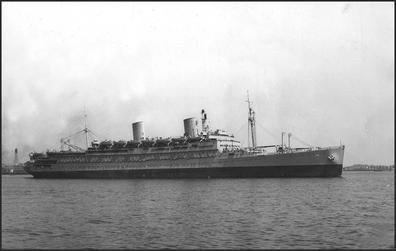Ordered 24 May 1930 Length 215 m Launched 20 August 1932 Beam 26 m | Laid down 20 January 1931 Commissioned 16 June 1941 Construction started 20 January 1931 Displacement 31.39 million kg | |
 | ||
Acquired (by the Navy) 16 June 1941 Builder New York Shipbuilding Corporation | ||
USS Mount Vernon (AP-22) was a troop transport that served with the United States Navy during World War II. Prior to her military service, she was a luxury ocean liner named SS Washington.
Contents
Washington was launched in May 1933 by the New York Shipbuilding Company of Camden, New Jersey, and operated as a passenger liner from New York City to Plymouth, England, and Hamburg, Germany. Renamed Mount Vernon 6 June 1941, the liner was acquired by the Navy 16 June 1941 and commissioned at the Philadelphia Navy Yard the same day, Captain Donald B. Beary in command.
Converted for naval use by Philadelphia Navy Yard, Mount Vernon trained along the east coast while mounting tension in the Far East drew the United States toward participation in World War II. In the fall, the new transport joined a convoy at Halifax, Nova Scotia, and sailed for Cape Town, South Africa. As Mount Vernon steamed toward Cape Horn, word arrived that Japan had attacked Pearl Harbor.
World War II
The transport, part of convoy DM.1, reached Singapore 13 January 1942. Here she debarked British and Canadian troops, watched dogfights between Japanese and British planes over the city, and underwent an air attack before sailing 16 January for Aden, where she embarked Australian veterans of the Mediterranean Theatre for transportation to Ceylon and Fremantle. Mount Vernon was the lead ship in Operation Stepsister, the movement of Australian troops from North Africa and the Middle East to Southeast Asia, the Dutch East Indies and Australia in response to war in the Pacific, and was carrying 4,668 of those troops in waters south of the Dutch East Indies even as allied naval forces were withdrawing in the face of Japanese attacks. On 9 March Mount Vernon delivered the returning Australian Imperial Force (A.I.F.) troops to Adelaide.
In Australia she embarked civilian and military escapees from the Philippines, and naval survivors from ships sunk in the Battle of Makassar Strait. After calls in Adelaide, South Australia and Wellington, New Zealand, Mount Vernon sailed for San Francisco, arriving 31 March.
For the next two years, Mount Vernon plied from San Francisco to ports in Australia, New Zealand, New Caledonia, and Hawaii, carrying the soldiers, marines, and sailors who would build the bases, then fight from them, bringing the ultimate victory over Japan. Her last such voyage began from San Francisco 21 February 1944. Steaming via Melbourne, she proceeded to Bombay, India, to debark Army personnel. She returned to Melbourne, and sailed for Boston by way of the Panama Canal, arriving 22 May.
On 4 June 1944, Mount Vernon began a series of voyages to British Isles ports and the Mediterranean, carrying men for the massive buildup on the European continent which would bring Germany to her knees. Her crossings continued after the war, as she carried occupation troops over and brought veterans home.
Decommissioning
Returning from the last voyage 3 January 1946, Mount Vernon decommissioned 18 January 1946, was delivered to the Maritime Commission, and again named Washington. She was struck from the Naval Register in 1959 and sold for scrap in 1965.
